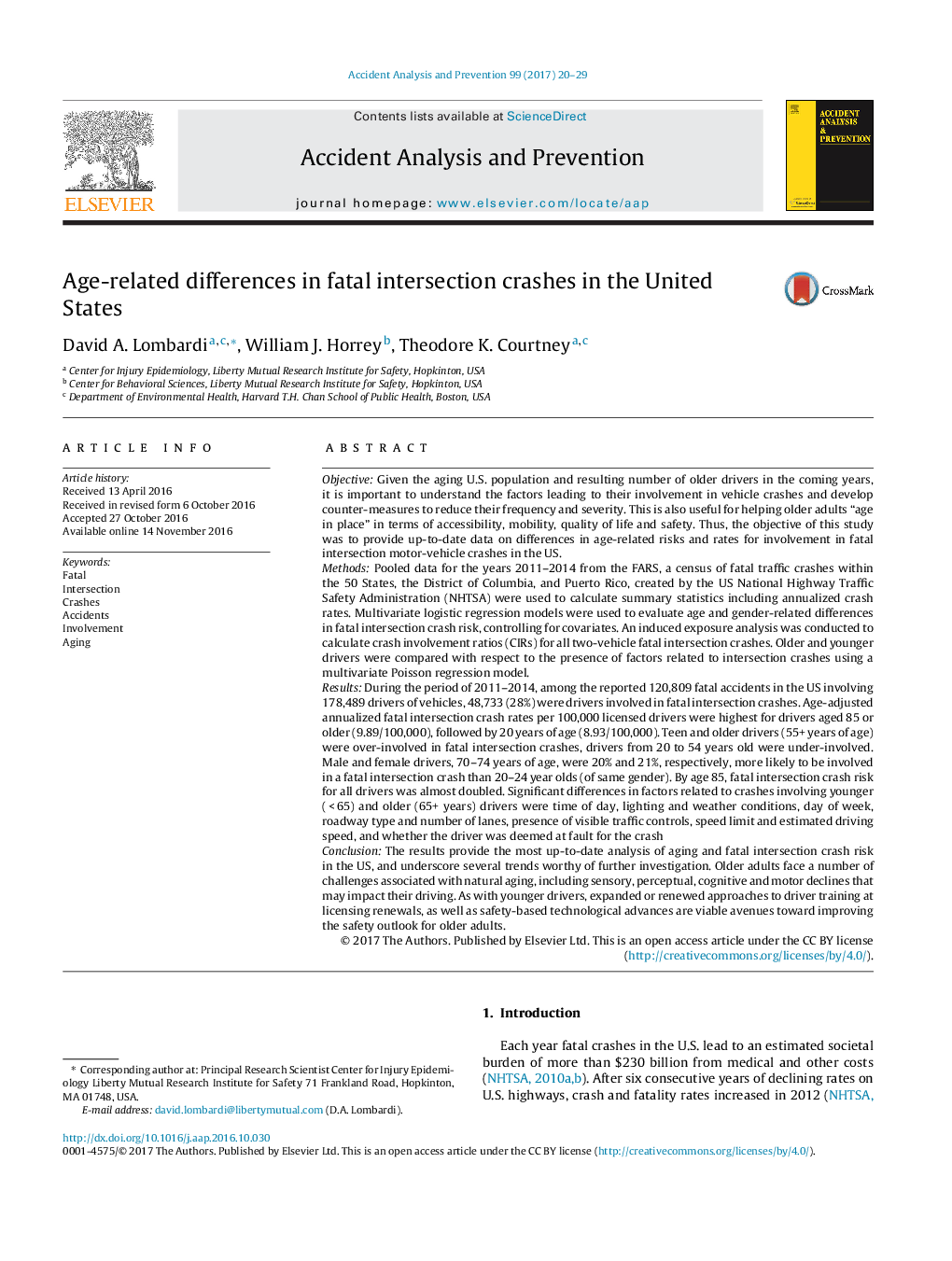| کد مقاله | کد نشریه | سال انتشار | مقاله انگلیسی | نسخه تمام متن |
|---|---|---|---|---|
| 4978858 | 1367783 | 2017 | 10 صفحه PDF | دانلود رایگان |
- Among 120,809 fatal accidents from 2011 to 2014 in the US, 28% were intersection crashes.
- Teen and older drivers (55+ years of age) were over-involved in fatal intersection crashes.
- Fatal intersection crash risk for female and male drivers almost doubles by age 85, compared to 20-24 years old.
- Factors associated with fatal intersection crashes are time and day of week, lighting, and weather conditions.
- Roadway type, number of lanes, speed limit, and visible traffic controls are important factors related to intersection crashes of younger and older drivers.
ObjectiveGiven the aging U.S. population and resulting number of older drivers in the coming years, it is important to understand the factors leading to their involvement in vehicle crashes and develop counter-measures to reduce their frequency and severity. This is also useful for helping older adults “age in place” in terms of accessibility, mobility, quality of life and safety. Thus, the objective of this study was to provide up-to-date data on differences in age-related risks and rates for involvement in fatal intersection motor-vehicle crashes in the US.MethodsPooled data for the years 2011-2014 from the FARS, a census of fatal traffic crashes within the 50 States, the District of Columbia, and Puerto Rico, created by the US National Highway Traffic Safety Administration (NHTSA) were used to calculate summary statistics including annualized crash rates. Multivariate logistic regression models were used to evaluate age and gender-related differences in fatal intersection crash risk, controlling for covariates. An induced exposure analysis was conducted to calculate crash involvement ratios (CIRs) for all two-vehicle fatal intersection crashes. Older and younger drivers were compared with respect to the presence of factors related to intersection crashes using a multivariate Poisson regression model.ResultsDuring the period of 2011-2014, among the reported 120,809 fatal accidents in the US involving 178,489 drivers of vehicles, 48,733 (28%) were drivers involved in fatal intersection crashes. Age-adjusted annualized fatal intersection crash rates per 100,000 licensed drivers were highest for drivers aged 85 or older (9.89/100,000), followed by 20 years of age (8.93/100,000). Teen and older drivers (55+ years of age) were over-involved in fatal intersection crashes, drivers from 20 to 54 years old were under-involved. Male and female drivers, 70-74 years of age, were 20% and 21%, respectively, more likely to be involved in a fatal intersection crash than 20-24Â year olds (of same gender). By age 85, fatal intersection crash risk for all drivers was almost doubled. Significant differences in factors related to crashes involving younger (Â <Â 65) and older (65+ years) drivers were time of day, lighting and weather conditions, day of week, roadway type and number of lanes, presence of visible traffic controls, speed limit and estimated driving speed, and whether the driver was deemed at fault for the crashConclusionThe results provide the most up-to-date analysis of aging and fatal intersection crash risk in the US, and underscore several trends worthy of further investigation. Older adults face a number of challenges associated with natural aging, including sensory, perceptual, cognitive and motor declines that may impact their driving. As with younger drivers, expanded or renewed approaches to driver training at licensing renewals, as well as safety-based technological advances are viable avenues toward improving the safety outlook for older adults.
Journal: Accident Analysis & Prevention - Volume 99, Part A, February 2017, Pages 20-29
